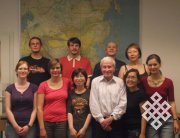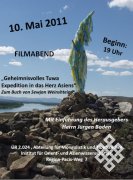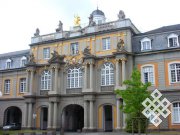 Although planned for April 12, it was on a sunny and warm evening of May 10 in Bonn, the former capital city of West Germany on the river Rhine, that the renowned University of Bonn through its Institute for Oriental and Asian Sciences, Department for Mongolistic and Tibetan Studies, had invited both its staff and students for an evening entirely dedicated to Tuva and its culture.
Although planned for April 12, it was on a sunny and warm evening of May 10 in Bonn, the former capital city of West Germany on the river Rhine, that the renowned University of Bonn through its Institute for Oriental and Asian Sciences, Department for Mongolistic and Tibetan Studies, had invited both its staff and students for an evening entirely dedicated to Tuva and its culture.
Alouette Verlag’s editor and publisher of the German edition of Sevyan Vainshtein’s famous book “Mysterious Tuva – Expeditions into the Heart of Asia” (with a DVD featuring the German version of Leonid Kruglov’s documentary “Sewn Arrows”) had been asked to introduce the author and his book to the assembled academic staff (see photo) and students.
 This event has been initiated and organized by Saylyk Kashbyk-ool, who came to Germany from Kyzyl in 2004 and who has studied Asian sciences at the University of Bonn, successfully obtaining her B.A. there (under Professor Veronica Veit) with her graduation paper about Tuva and its culture.
This event has been initiated and organized by Saylyk Kashbyk-ool, who came to Germany from Kyzyl in 2004 and who has studied Asian sciences at the University of Bonn, successfully obtaining her B.A. there (under Professor Veronica Veit) with her graduation paper about Tuva and its culture.
The evening began with some technical difficulties, during which Alouette Verlag’s Jürgen Boden had ample opportunity to talk about his first meeting with Professor Vainshtein in Moscow in 2001 (arranged with the recommendation of Professor Peter P. Schweitzer of the University of Alaska in Fairbanks), where he had been invited to stay for many days in the apartment of Sevyan Vainshtein and his wife Alevtina, a warm-hearted and hospitable music pedagogue, working day and night on the forthcoming book, and being introduced there as well to the ethnologist (and German speaking) Dr. Dmitrij Funk of the RAS, and to filmmaker Leonid Kruglov. When the German version of the book was finally ready to being published in 2005, Jürgen Boden and his wife went to Moscow again to present the book with DVD to Professor Vainshtein, to Leonid Kruglov, and to the assembled faculty of the Institute of Ethnology and Anthropology and the press on April 12, the author’s birthday.
At the evening in Bonn, the lengthy development of the book and its details were explained to the attentive audience (with the book itself being circled from one hand to the next), as was the colourful story of the making of the film documentary, the “red line” of which was based on the correspondence of Sevyan Vainshtein with Nobel Prize laureate Richard P. Feynman, the famous American physicist, who had desperately wanted to visit Tuva in the 1980s and who had asked Dr. Vainshtein for his help in obtaining a visa for the USSR, but by the time this was ready to be issued, Dr. Feynman had died.
The lively Q & A period at the seminar was “rewarded” with the settlement of the technical problems, and the attending people were ready to also  view Leonid Kruglov’s 72-minute film, reviving the explorations of Dr. Vainshtein in Tuva and surrounding republics. The film was well received and applauded, thus making sure that the book “Mysterious Tuva” with its DVD will spread the knowledge of Tuvan culture and history within the academic world of Germany.
view Leonid Kruglov’s 72-minute film, reviving the explorations of Dr. Vainshtein in Tuva and surrounding republics. The film was well received and applauded, thus making sure that the book “Mysterious Tuva” with its DVD will spread the knowledge of Tuvan culture and history within the academic world of Germany.
And finally, it is so unfortunate, that Professor Vainshtein has passed away in October 2008, shortly after having held in his hand a preliminary copy of the Russian version of this book, which was his last major work beyond his many monographs and 300 scientific publications which constitute an enormous life-work of one of Russia’s renowned explorers, ethnographers and historians. This particular book, suggested to Sevyan Vainshtein by Norwegian explorer Thor Heyerdahl at a Moscow scientific conference in 1964 already, is both in its German and Russian version the summery of 50 years of scientific work in Central Asia, particularly in and around Tuva, of valuable friendships with Tuvan personalities, and of very private experiences and emotions. With his death, the scientific world has lost a most remarkable man (see also the Wikipedia entry of 2009), and his wife and daughter have lost a loving husband and father.
Photos and design of flyer by Saylyk Kashbyk-ool

